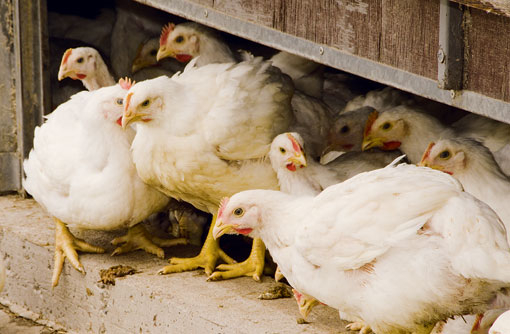Free Range Chicken meets the challenges

While life in free-range broiler production is not without its challenges, it is an area that has experienced steady growth over the past few years, says Anna Rountree, quality assurance audit manager at Free Range Chicken.
The company, which has been in existence for 10 years, now has 66 farms spread across the east of England, producing some 160,000 birds every week.
“We are small compared to the standard broiler producers, but it is still a significant number of birds and we have had to increase our capacity over the past few years,” she says.
“We are also involved in organic free-range production and I think some people have traded down from organic to free range. More people are seeing a free-range roaster bird as a treat for a special occasion.
“I think you can tell the difference in terms of taste; the birds are more active and they have a different diet.”
Stocking densities are strictly controlled by EU legislation with a limit of 27.5kg/sq m as opposed to 38kg/sq m for standard broiler producers. There is also a minimum slaughter age of 56 days, and for at least half of that time the birds must have access to the outdoors.
Ms Rountree says: “We use slower growing breeds, which take longer to get to their finishing weight and that improves the eating quality, flavour and muscle texture.”
“More people are seeing a free-range roaster bird as a treat for a special occasion”
Anna Rountree
Housing
Free Range Chicken uses both fixed and mobile chicken houses on its farms. The flock sizes in the fixed houses vary from about 5,000-20,000. These houses are home to the chickens throughout their lives – from when they come on to the farms as day-old chicks until they are sent to the processor at 56 days.
With the mobile houses, the chickens are reared on a brood farm, where the farm manager has specialist husbandry skills in brooding practices. They are then moved to the mobile units at 28 days, or 33 days for an organic bird.
On each “grow-out” farm the mobile houses are moved every crop to ensure the birds have access to fresh pasture. There can be anything from 500-1,500 birds in each unit. They get natural ventilation and natural lighting periods.
For organic birds, the growing cycle is even longer, with birds finishing at 73 days. Because of the slow development rate and the fact that they are much more active, they produce a much leaner bird. Stocking densities are also lower. Other differences include the 95% organic content of the diet, and the fact that any land treatment must be organic, with no pesticide use.
Challenges
Free range also brings a number of challenges that you wouldn’t get with standard broiler production. This includes predators such as birds and foxes, and not least humans. The weather is another problem that affects free-range production to a much greater extent.
“The past year has been by far the wettest in living memory and to keep the birds clean is difficult for the managers,” says Ms Rountree.
As with any flock, bird health and welfare is of paramount importance and all flocks have a health programme produced in consultation with Free Range Chickens’ vets. The company has been working closely with Merial Animal Health over a number of years to provide protection against Gumboro and Marek’s disease. It uses Vaxxitek HVT+IBD, administered to day-old chicks in the hatchery.
“Obviously the birds are on the ground a lot longer and they need complete protection throughout their lives,” explains Ms Rountree. “Merial also provides support in terms of vaccination audits at the hatchery, and we take follow-on bloods on the farms that are then tested to make sure that the vaccine has worked and that the birds have the necessary immunity. Antibiotic usage across the business is extremely low, which is a strong selling point for outdoor reared birds.
“For free-range birds, avian influenza is also a threat, but by enforcing top-level biosecurity we manage that on our farms. A robust vaccination programme, top management and lower stocking densities help to produce a healthy, robust bird.”
Catch up with the latest poultry news
